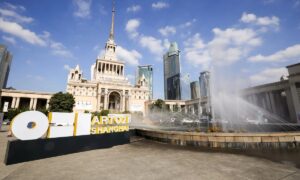
Museums across the UK, including the Southbank Centre in London, York Castle Museum and Museum Wales, are conducting urgent investigations into the safety of their structures because of the possible presence of a potentially dangerous form of concrete. At the time of publication, Cardiff Council revealed that the roof of Wales’s national concert hall, St David’s Hall, would have to be replaced, following the discovery of the concrete-like material Raac (reinforced autoclaved aerated concrete).Raac was widely used in construction from the 1950s to 1990s, in the UK and around the world, as a cheaper, lightweight alternative to conventional concrete. Mass-produced precast panels were installed in roofs and occasionally in walls and floors. In recent years, however, experts have raised the alarm over the risks of Raac failure. Its bubbly structure means it is relatively weak, highly porous and vulnerable when exposed to water. With an estimated design life of only 30 years, it is liable to fracture and collapse suddenly if its structural integrity is compromised.In June, the UK government ordered all departments to search their estates for Raac. The inquiry turned into a political crisis in August when more than 100 schools in England were abruptly closed, days before students were due to return after the summer holidays. The Prime Minister, Rishi Sunak, said the government “will ensure the safety of children and these buildings”. The Royal Institute of British Architects and other observers pointed to years of underinvestment in deteriorating schools and other public buildings being at the root of the crisis.Partial closureThe problem is not confined to schools—hospitals, courts, and a number of cultural and heritage buildings have been linked to Raac concerns. As we went to press, York Castle Museum was partially closed for its second inspection after Raac was confirmed. The material is present in the roofing of the building’s north side, which houses permanent displays including Kirkgate, the popular recreation of a Victorian street. York Museums Trust says those areas will remain closed until further notice, though the rest of the museum is open (with a reduced ticket price).No Raac has been identified at the trust’s other venues, which include York Art Gallery and Yorkshire Museum.Cardiff’s St David’s Hall initially closed in September for inspections of its roof, but the city council now says the building will be shut for 18 months in order to replace the roof.Small amounts of the concrete were also confirmed in the Houses of Parliament and in backstage areas of the National Theatre in London but they have been described as posing no immediate safety risk.The Art Newspaper contacted leading UK cultural institutions to ask whether Raac had been used in the construction or renovation of their buildings.According to Amgueddfa Cymru (Museum Wales), which runs seven venues: “It’s likely that Raac has been used somewhere across our estate, but we believe that it is minimal and will not pose a risk to staff or visitors. We will review our records to ensure this belief is well founded.”InvestigationsIn London, specialists are investigating whether Raac is present in any of the four venues of the Brutalist Southbank Centre. The Grade I-listed Royal Festival Hall opened in 1951, followed by the Queen Elizabeth Hall, Purcell Room and Hayward Gallery in the 1960s. “We take the safety of our staff and visitors very seriously and we will update in due course,” a spokesperson says.The Science Museum, London, also confirmed an internal investigation. A spokesperson says: “While no evidence of Raac use was revealed by an initial desktop assessment, we are continuing with a more detailed assessment of a small number of buildings that were constructed during the relevant period.”The Royal Academy of Arts in London told us it is “currently reviewing its site in detail to confirm that Raac has not been used”.The Victoria and Albert Museum, British Museum and National Galleries Scotland in Edinburgh all confirmed that there is no record of Raac being used in any of their buildings, although regular surveys are conducted. A spokesperson for the Barbican Centre, a Brutalist landmark with an abundant use of concrete, says: “There is no Raac concrete at the Barbican.”Damage inside a school in Leicester that has reinforced autoclaved aerated concrete (Raac). In August more than 100 schools were closed out of fear that they contained RaacPA Images/Alamy Stock Photo‘Enormously concerning’The architectural historian and concrete conservation expert Catherine Croft, director of the Twentieth Century Society campaign group, says it is “probable” that varying amounts of Raac will emerge in the UK’s cultural buildings. This will likely include council-owned museums, arts centres and libraries as well as renovated heritage buildings.The presence of potentially compromised concrete in these public spaces is “clearly enormously concerning”, Croft says. “There is an urgent need to understand where Raac was used, to examine whether or not it is now failing in each case, and then work out how best to repair or replace every building which requires urgent attention.”Raac’s prevalence in the hidden fabric of roofs and walls means, however, that “it’s going to take quite a long time to determine” the full extent of which buildings have the material, she adds. “Unless you have meticulous records, or you’ve had to rebuild—removing the plaster and roofing felt—you wouldn’t know.”Fortunately, the post-war heyday of Raac “wasn’t a big period of time for new museum buildings” in the UK, says Lisa Ollerhead, the director of the Association of Independent Museums (Aim). A charity that supports more than 1,000 museum and heritage organisations, Aim recently surveyed its members about Raac-related concerns. Of the 250 respondents, mostly small independent museums in England, more than 90% confirmed there was no Raac in their buildings.Need for capital Yet after several challenging years for museum finances, the report points to wider concerns about repairing crumbling buildings. Capital funding for museum maintenance was the “biggest single ask” among survey respondents, Ollerhead says, with 44% saying they needed support in the coming months. There was already “an enormous need” in 2019 when the government launched the Museum Estate and Development Fund (Mend) via Arts Council England, she adds, and “the backlog of maintenance has been growing” since then.“You can’t run a museum and do the cool stuff without a building that is not falling down”Aim will advocate for government support to continue Mend beyond 2024 and for equivalent grant-making funds to be established in Scotland, Wales and Northern Ireland. Though far less visible or glamorous than capital spending on new galleries, maintenance is “absolutely crucial”, Ollerhead says. “You can’t run a museum and do the cool stuff without a building that is not falling down.”Presentations at the UK Museums Association’s annual conference on 7-9 November were due to address what it describes as a “crisis in English civic museums”, precipitated by 60% cuts to their core funding from local councils over the past five years and “vastly escalating running costs”.The “massive under-resourcing problem” also means that councils could overlook the heritage impacts of Raac in 20th-century buildings that are not formally protected by listing, says Lydia Gibson, the head of policy at The Heritage Alliance. Representing nearly 200 heritage bodies in England, the organisation is gathering evidence on Raac for the Department for Digital, Culture, Media and Sport (DCMS).“There could be a rush to demolish and rebuild modern buildings in the race to remove Raac without thinking about the potential heritage value of those places”“There could be a rush to demolish and rebuild modern buildings in the race to remove Raac,” Gibson warns, “without sitting back and doing the necessary thinking about the potential heritage value of those places.” A 2020 report by the Institute of Historic Building Conservation noted that the specialist conservation advice available to English local authorities had declined by 49% since 2009. There is a risk, Gibson says, that councils lack both the expertise to assess Raac in a heritage context and the funding needed to remedy it.UK building managers also face paying VAT of 20% on repairs, whereas demolition is zero-rated. Reforming the tax regime would “offer a lifeline for sites struggling to afford repairs” and encourage a more sustainable approach, Gibson says.• Additional reporting by Gareth Harris


























